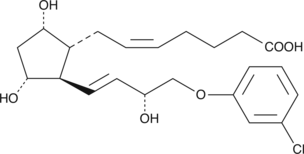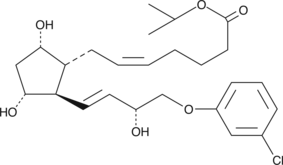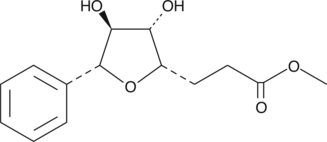Cayman
Showing 151–300 of 45550 results
-
(+)-Blebbistatin is the inactive enantiomer of (–)-blebbistatin (Item No. 13013), which is a selective inhibitor of non-muscle myosin II ATPases.{16452,17037} Prolonged exposure to blue light (450-490 nm) results in degradation of blebbistatin to an inactive product via cytotoxic intermediates, which may be problematic for its use in fluorescent live cell imaging applications.{17038,24037} (R)-nitro-Blebbistatin (Item No. 9001935) is a more stable form of (+)-blebbistatin.{16725} The addition of a nitro group stabilizes the molecule to circumvent its degradation by prolonged blue light exposure. (R)-nitro-Blebbistatin has the same stereochemistry as the inactive (+)-blebbistatin enantiomer.
Brand:CaymanSKU:-(+)-Borneol is a bicyclic monoterpene and a stereoisomer of (–)-borneol (Item No. 23468) that has been found in various plants, including S. tomentosa, and has diverse biological activities including analgesic, neuroprotective, antioxidant, and antimicrobial properties.{36773,36860,36861,36862} (+)-Borneol is a positive allosteric modulator of α1β2γ2L subunit-containing GABAA receptors (EC50 = 248 μM for human recombinant receptors).{36773} It dose-dependently increases the paw withdrawal threshold following segmental spinal nerve ligation surgery or intraplantar injection of complete Freund’s adjuvant (CFA) in mouse paw.{36860} (+)-Borneol (100 μM) inhibits increases in reactive oxygen species (ROS) levels and cytotoxicity in SH-SY5Y neuroblastoma cells incubated with amyloid-β (1-42) (Aβ42; Item No. 20574).{36861} It also inhibits the growth of Gram-positive and Gram-negative bacteria in vitro, including E. coli, S. aureus, P. aeruginosa, P. vulgaris, and S. typhimurium (MICs = 125-250 μg/mL).{36862} Formulations containing (+)-borneol have been used as fragrance ingredients.
Brand:CaymanSKU:23467 - 1 gAvailable on backorder
(+)-Borneol is a bicyclic monoterpene and a stereoisomer of (–)-borneol (Item No. 23468) that has been found in various plants, including S. tomentosa, and has diverse biological activities including analgesic, neuroprotective, antioxidant, and antimicrobial properties.{36773,36860,36861,36862} (+)-Borneol is a positive allosteric modulator of α1β2γ2L subunit-containing GABAA receptors (EC50 = 248 μM for human recombinant receptors).{36773} It dose-dependently increases the paw withdrawal threshold following segmental spinal nerve ligation surgery or intraplantar injection of complete Freund’s adjuvant (CFA) in mouse paw.{36860} (+)-Borneol (100 μM) inhibits increases in reactive oxygen species (ROS) levels and cytotoxicity in SH-SY5Y neuroblastoma cells incubated with amyloid-β (1-42) (Aβ42; Item No. 20574).{36861} It also inhibits the growth of Gram-positive and Gram-negative bacteria in vitro, including E. coli, S. aureus, P. aeruginosa, P. vulgaris, and S. typhimurium (MICs = 125-250 μg/mL).{36862} Formulations containing (+)-borneol have been used as fragrance ingredients.
Brand:CaymanSKU:23467 - 500 mgAvailable on backorder
Catechin is a polyphenolic flavonoid which has been isolated from a variety of natural sources including tea leaves, grape seeds, and the wood and bark of trees such as acacia and mahogany. Catechin is a more potent antioxidant than ascorbate or α-tocopherol in certain in vitro assays of lipid peroxidation.{7582} Catechin inhibits the free radical-induced oxidation of isolated LDL by AAPH.{7442} It has also been reported to act as an inhibitor of COX-1 with an IC50 of about 80 µM.{8140} Catechin and other related procyanidin compounds have antitumor activity when tested in a two-stage mouse epidermal carcinoma model employing topical application.{7582}
Brand:CaymanSKU:70940 - 1 gAvailable on backorder
Catechin is a polyphenolic flavonoid which has been isolated from a variety of natural sources including tea leaves, grape seeds, and the wood and bark of trees such as acacia and mahogany. Catechin is a more potent antioxidant than ascorbate or α-tocopherol in certain in vitro assays of lipid peroxidation.{7582} Catechin inhibits the free radical-induced oxidation of isolated LDL by AAPH.{7442} It has also been reported to act as an inhibitor of COX-1 with an IC50 of about 80 µM.{8140} Catechin and other related procyanidin compounds have antitumor activity when tested in a two-stage mouse epidermal carcinoma model employing topical application.{7582}
Brand:CaymanSKU:70940 - 10 gAvailable on backorder
Catechin is a polyphenolic flavonoid which has been isolated from a variety of natural sources including tea leaves, grape seeds, and the wood and bark of trees such as acacia and mahogany. Catechin is a more potent antioxidant than ascorbate or α-tocopherol in certain in vitro assays of lipid peroxidation.{7582} Catechin inhibits the free radical-induced oxidation of isolated LDL by AAPH.{7442} It has also been reported to act as an inhibitor of COX-1 with an IC50 of about 80 µM.{8140} Catechin and other related procyanidin compounds have antitumor activity when tested in a two-stage mouse epidermal carcinoma model employing topical application.{7582}
Brand:CaymanSKU:70940 - 25 gAvailable on backorder
Catechin is a polyphenolic flavonoid which has been isolated from a variety of natural sources including tea leaves, grape seeds, and the wood and bark of trees such as acacia and mahogany. Catechin is a more potent antioxidant than ascorbate or α-tocopherol in certain in vitro assays of lipid peroxidation.{7582} Catechin inhibits the free radical-induced oxidation of isolated LDL by AAPH.{7442} It has also been reported to act as an inhibitor of COX-1 with an IC50 of about 80 µM.{8140} Catechin and other related procyanidin compounds have antitumor activity when tested in a two-stage mouse epidermal carcinoma model employing topical application.{7582}
Brand:CaymanSKU:70940 - 5 gAvailable on backorder
(+)-Cedrol is a sesquiterpene alcohol that has been used in Cannabis testing and has diverse biological activities.{42271} It inhibits the growth of L. sulphureus, G. trabeum, L. betulina, and T. versicolor wood decay fungi when used at a concentration of 100 μg/ml.{36905} (+)-Cedrol inhibits the cytochrome P450 (CYP) isoforms CYP2B6 and CYP3A4 (Kis = 0.9 and 3.4 μM, respectively).{36906} In vivo, (+)-cedrol (200 mg/kg) prevents hair follicle dystrophy and reduces hair loss in a mouse model of alopecia induced by cyclophosphamide (Item No. 13849).{36907} (+)-Cedrol-loaded nanostructured lipid particles reduce peritoneal mast cell degranulation, a component of the type I anaphylactic response, induced by compound 48/80 (Item No. 22173) in mice.{36908}
Brand:CaymanSKU:25769 - 100 mgAvailable on backorder
(+)-Cedrol is a sesquiterpene alcohol that has been used in Cannabis testing and has diverse biological activities.{42271} It inhibits the growth of L. sulphureus, G. trabeum, L. betulina, and T. versicolor wood decay fungi when used at a concentration of 100 μg/ml.{36905} (+)-Cedrol inhibits the cytochrome P450 (CYP) isoforms CYP2B6 and CYP3A4 (Kis = 0.9 and 3.4 μM, respectively).{36906} In vivo, (+)-cedrol (200 mg/kg) prevents hair follicle dystrophy and reduces hair loss in a mouse model of alopecia induced by cyclophosphamide (Item No. 13849).{36907} (+)-Cedrol-loaded nanostructured lipid particles reduce peritoneal mast cell degranulation, a component of the type I anaphylactic response, induced by compound 48/80 (Item No. 22173) in mice.{36908}
Brand:CaymanSKU:25769 - 250 mgAvailable on backorder
(+)-Chloropseudoephedrine is a contaminant produced during the illicit manufacture of (+)-methamphetamine (Item No. 13997) when (+)-pseudoephedrine or (-)-ephedrine are used as precursors.{29545,29544} Chloroephedrine has been reported to be present in varying levels in clandestinely synthesized methamphetamine and has been observed in some forensic samples.{29546} This product is intended for forensic and research purposes.
Brand:CaymanSKU:9002347 - 1 mgAvailable on backorder
(+)-Chloropseudoephedrine is a contaminant produced during the illicit manufacture of (+)-methamphetamine (Item No. 13997) when (+)-pseudoephedrine or (-)-ephedrine are used as precursors.{29545,29544} Chloroephedrine has been reported to be present in varying levels in clandestinely synthesized methamphetamine and has been observed in some forensic samples.{29546} This product is intended for forensic and research purposes.
Brand:CaymanSKU:9002347 - 5 mgAvailable on backorder
(+)-Chloropseudoephedrine is a contaminant produced during the illicit manufacture of (+)-methamphetamine (Item No. 13997) when (+)-pseudoephedrine or (-)-ephedrine are used as precursors.{29545,29544} Chloroephedrine has been reported to be present in varying levels in clandestinely synthesized methamphetamine and has been observed in some forensic samples.{29546} This product is intended for forensic and research purposes.
Brand:CaymanSKU:9002347 - 500 µgAvailable on backorder
(+)-Cloprostenol is a synthetic analog of prostaglandin F2α (PGF2α). It is an FP receptor agonist and a potent luteolytic agent in rats and hamsters. (+)-Cloprostenol is the optically active, 15(R) enantiomer of cloprostenol responsible for the majority of its biological activity. It is 200 times more potent than PGF2α in terminating pregnancy when given subcutaneously at a daily dose of 0.125 μg/kg in rats and hamsters, without the side effects associated with PGF2α.{1182} (+)-Cloprostenol was also shown to be a potent inhibitor of rat adipose precursor differentiation in primary cultures with an IC50 value of 3 pM.{4404}
Brand:CaymanSKU:-Out of stock
(+)-Cloprostenol is a synthetic analog of prostaglandin F2α (PGF2α). It is an FP receptor agonist and a potent luteolytic agent in rats and hamsters. (+)-Cloprostenol is the optically active, 15(R) enantiomer of cloprostenol responsible for the majority of its biological activity. It is 200 times more potent than PGF2α in terminating pregnancy when given subcutaneously at a daily dose of 0.125 μg/kg in rats and hamsters, without the side effects associated with PGF2α.{1182} (+)-Cloprostenol was also shown to be a potent inhibitor of rat adipose precursor differentiation in primary cultures with an IC50 value of 3 pM.{4404}
Brand:CaymanSKU:-Out of stock
(+)-Cloprostenol is a synthetic analog of prostaglandin F2α (PGF2α). It is an FP receptor agonist and a potent luteolytic agent in rats and hamsters. (+)-Cloprostenol is the optically active, 15(R) enantiomer of cloprostenol responsible for the majority of its biological activity. It is 200 times more potent than PGF2α in terminating pregnancy when given subcutaneously at a daily dose of 0.125 μg/kg in rats and hamsters, without the side effects associated with PGF2α.{1182} (+)-Cloprostenol was also shown to be a potent inhibitor of rat adipose precursor differentiation in primary cultures with an IC50 value of 3 pM.{4404}
Brand:CaymanSKU:-Out of stock
(+)-Cloprostenol (sodium salt) is a more water soluble, crystalline form of (+)-cloprostenol. (+)-Cloprostenol is a synthetic analog of prostaglandin F2α (PGF2α). It is an FP receptor agonist and a potent luteolytic agent in rats and hamsters. (+)-Cloprostenol is the optically active, 15(R) enantiomer of cloprostenol responsible for the majority of its biological activity. Cloprostenol is 200 times and 100 times more potent than PGF2α in terminating pregnancy in hamsters and rats, respectively without the side effects associated with PGF2α.{1182} The subcutaneous dose required for interrupting early pregnancy is species dependent, requiring approximately 1.25 µg/kg and 270 µg/kg in hamsters and rats, respectively.{1182} Cloprostenol is also a potent inhibitor of rat adipose precursor differentiation in primary cultures with an IC50 of 3 x 10−12 M.{4404}
Brand:CaymanSKU:-Out of stock
(+)-Cloprostenol (sodium salt) is a more water soluble, crystalline form of (+)-cloprostenol. (+)-Cloprostenol is a synthetic analog of prostaglandin F2α (PGF2α). It is an FP receptor agonist and a potent luteolytic agent in rats and hamsters. (+)-Cloprostenol is the optically active, 15(R) enantiomer of cloprostenol responsible for the majority of its biological activity. Cloprostenol is 200 times and 100 times more potent than PGF2α in terminating pregnancy in hamsters and rats, respectively without the side effects associated with PGF2α.{1182} The subcutaneous dose required for interrupting early pregnancy is species dependent, requiring approximately 1.25 µg/kg and 270 µg/kg in hamsters and rats, respectively.{1182} Cloprostenol is also a potent inhibitor of rat adipose precursor differentiation in primary cultures with an IC50 of 3 x 10−12 M.{4404}
Brand:CaymanSKU:-Out of stock
(+)-Cloprostenol (sodium salt) is a more water soluble, crystalline form of (+)-cloprostenol. (+)-Cloprostenol is a synthetic analog of prostaglandin F2α (PGF2α). It is an FP receptor agonist and a potent luteolytic agent in rats and hamsters. (+)-Cloprostenol is the optically active, 15(R) enantiomer of cloprostenol responsible for the majority of its biological activity. Cloprostenol is 200 times and 100 times more potent than PGF2α in terminating pregnancy in hamsters and rats, respectively without the side effects associated with PGF2α.{1182} The subcutaneous dose required for interrupting early pregnancy is species dependent, requiring approximately 1.25 µg/kg and 270 µg/kg in hamsters and rats, respectively.{1182} Cloprostenol is also a potent inhibitor of rat adipose precursor differentiation in primary cultures with an IC50 of 3 x 10−12 M.{4404}
Brand:CaymanSKU:-Out of stock
(+)-Cloprostenol is a synthetic analog of prostaglandin F2α (PGF2α). It is an FP receptor agonist and a potent luteolytic agent in rats and hamsters. (+)-Cloprostenol is the optically active, 15(R) enantiomer of cloprostenol responsible for the majority of its biological activity. It is 200 times more potent than PGF2α in terminating pregnancy when given subcutaneously at a daily dose of 0.125 μg/kg in rats and hamsters, without the side effects associated with PGF2α.{1182} (+)-Cloprostenol was also shown to be a potent inhibitor of rat adipose precursor differentiation in primary cultures with an IC50 value of 3 x 10-12 M.{4404} (+)-Cloprostenol isopropyl ester is a more lipid soluble form of cloprostenol.
Brand:CaymanSKU:10010016 - 1 mgAvailable on backorder
(+)-Cloprostenol is a synthetic analog of prostaglandin F2α (PGF2α). It is an FP receptor agonist and a potent luteolytic agent in rats and hamsters. (+)-Cloprostenol is the optically active, 15(R) enantiomer of cloprostenol responsible for the majority of its biological activity. It is 200 times more potent than PGF2α in terminating pregnancy when given subcutaneously at a daily dose of 0.125 μg/kg in rats and hamsters, without the side effects associated with PGF2α.{1182} (+)-Cloprostenol was also shown to be a potent inhibitor of rat adipose precursor differentiation in primary cultures with an IC50 value of 3 x 10-12 M.{4404} (+)-Cloprostenol isopropyl ester is a more lipid soluble form of cloprostenol.
Brand:CaymanSKU:10010016 - 10 mgAvailable on backorder
(+)-Cloprostenol is a synthetic analog of prostaglandin F2α (PGF2α). It is an FP receptor agonist and a potent luteolytic agent in rats and hamsters. (+)-Cloprostenol is the optically active, 15(R) enantiomer of cloprostenol responsible for the majority of its biological activity. It is 200 times more potent than PGF2α in terminating pregnancy when given subcutaneously at a daily dose of 0.125 μg/kg in rats and hamsters, without the side effects associated with PGF2α.{1182} (+)-Cloprostenol was also shown to be a potent inhibitor of rat adipose precursor differentiation in primary cultures with an IC50 value of 3 x 10-12 M.{4404} (+)-Cloprostenol isopropyl ester is a more lipid soluble form of cloprostenol.
Brand:CaymanSKU:10010016 - 5 mgAvailable on backorder
(+)-Cloprostenol is a synthetic analog of prostaglandin F2α (PGF2α). It is an FP receptor agonist and a potent luteolytic agent in rats and hamsters. It is 200 times and 100 times more potent than PGF2α in terminating pregnancy in hamsters and rats, respectively, without the side effects associated with PGF2α.{1182} Cloprostenol is also used in veterinary medicine as a luteolytic agent for the induction of estrus and the treatment of reproductive disorders in cattle, swine, and horses. (+)-Cloprostenol methyl ester is a more lipid soluble form of cloprostenol, which may be more amenable for certain formulations.
Brand:CaymanSKU:10010115 - 1 mgAvailable on backorder
(+)-Cloprostenol is a synthetic analog of prostaglandin F2α (PGF2α). It is an FP receptor agonist and a potent luteolytic agent in rats and hamsters. It is 200 times and 100 times more potent than PGF2α in terminating pregnancy in hamsters and rats, respectively, without the side effects associated with PGF2α.{1182} Cloprostenol is also used in veterinary medicine as a luteolytic agent for the induction of estrus and the treatment of reproductive disorders in cattle, swine, and horses. (+)-Cloprostenol methyl ester is a more lipid soluble form of cloprostenol, which may be more amenable for certain formulations.
Brand:CaymanSKU:10010115 - 10 mgAvailable on backorder
(+)-Cloprostenol is a synthetic analog of prostaglandin F2α (PGF2α). It is an FP receptor agonist and a potent luteolytic agent in rats and hamsters. It is 200 times and 100 times more potent than PGF2α in terminating pregnancy in hamsters and rats, respectively, without the side effects associated with PGF2α.{1182} Cloprostenol is also used in veterinary medicine as a luteolytic agent for the induction of estrus and the treatment of reproductive disorders in cattle, swine, and horses. (+)-Cloprostenol methyl ester is a more lipid soluble form of cloprostenol, which may be more amenable for certain formulations.
Brand:CaymanSKU:10010115 - 5 mgAvailable on backorder
CP 101,606 is a noncompetitive antagonist of NDMA receptors containing the NR2B subunit (Kd = 4.2 nM).{39515} CP 101,606 is highly selective for NR1/NR2B-containing NMDA receptors over NR1, NR2A, and NR2B subunits alone and NR1/NR2A receptors in HEK293 cell homogenates. In vivo, CP 101,606 (30 mg/kg, s.c.) inhibits mechanical hyperalgesia following carrageenan challenge in rats.{39516} It also inhibits licking behavior in rats induced by capsaicin (Item No. 92350) and phorbol-12-myristate-13-acetate (PMA; Item No. 10008014; ED50s = 7.5 and 5.7 mg/kg, respectively). CP 101,606 reverses catalepsy in rats induced by haloperidol (Item No. 12014) with an ED50 value of 0.4 mg/kg.{39517} CP 101,606 (1 mg/kg, s.c.) alone or in combination with L-DOPA methyl ester (Item No. 16149) temporarily improves parkinsonian symptoms in an MPTP model of Parkinson’s disease in rhesus monkeys.
Brand:CaymanSKU:23884 - 10 mgAvailable on backorder
CP 101,606 is a noncompetitive antagonist of NDMA receptors containing the NR2B subunit (Kd = 4.2 nM).{39515} CP 101,606 is highly selective for NR1/NR2B-containing NMDA receptors over NR1, NR2A, and NR2B subunits alone and NR1/NR2A receptors in HEK293 cell homogenates. In vivo, CP 101,606 (30 mg/kg, s.c.) inhibits mechanical hyperalgesia following carrageenan challenge in rats.{39516} It also inhibits licking behavior in rats induced by capsaicin (Item No. 92350) and phorbol-12-myristate-13-acetate (PMA; Item No. 10008014; ED50s = 7.5 and 5.7 mg/kg, respectively). CP 101,606 reverses catalepsy in rats induced by haloperidol (Item No. 12014) with an ED50 value of 0.4 mg/kg.{39517} CP 101,606 (1 mg/kg, s.c.) alone or in combination with L-DOPA methyl ester (Item No. 16149) temporarily improves parkinsonian symptoms in an MPTP model of Parkinson’s disease in rhesus monkeys.
Brand:CaymanSKU:23884 - 25 mgAvailable on backorder
CP 101,606 is a noncompetitive antagonist of NDMA receptors containing the NR2B subunit (Kd = 4.2 nM).{39515} CP 101,606 is highly selective for NR1/NR2B-containing NMDA receptors over NR1, NR2A, and NR2B subunits alone and NR1/NR2A receptors in HEK293 cell homogenates. In vivo, CP 101,606 (30 mg/kg, s.c.) inhibits mechanical hyperalgesia following carrageenan challenge in rats.{39516} It also inhibits licking behavior in rats induced by capsaicin (Item No. 92350) and phorbol-12-myristate-13-acetate (PMA; Item No. 10008014; ED50s = 7.5 and 5.7 mg/kg, respectively). CP 101,606 reverses catalepsy in rats induced by haloperidol (Item No. 12014) with an ED50 value of 0.4 mg/kg.{39517} CP 101,606 (1 mg/kg, s.c.) alone or in combination with L-DOPA methyl ester (Item No. 16149) temporarily improves parkinsonian symptoms in an MPTP model of Parkinson’s disease in rhesus monkeys.
Brand:CaymanSKU:23884 - 5 mgAvailable on backorder
CP 47,497 is a bicyclic CB analog with potent analgesic activity.{16402} It is comparable or more potent than Δ9-tetrahydrocannabinol in analgesic, motor depressant, anticonvulsant, and hypothermic effects in mice, rats, and dogs.{17029} The dextrorotatory enantiomer, (+)-CP 47,497 avidly binds the CB1 receptor (Ki = 4.15 nM).{17030}
Brand:CaymanSKU:-CP 47,497 is a bicyclic CB analog with potent analgesic activity.{16402} It is comparable or more potent than Δ9-tetrahydrocannabinol in analgesic, motor depressant, anticonvulsant, and hypothermic effects in mice, rats, and dogs.{17029} The dextrorotatory enantiomer, (+)-CP 47,497 avidly binds the CB1 receptor (Ki = 4.15 nM).{17030}
Brand:CaymanSKU:-CP 47,497 is a bicyclic CB analog with potent analgesic activity.{16402} It is comparable or more potent than Δ9-tetrahydrocannabinol in analgesic, motor depressant, anticonvulsant, and hypothermic effects in mice, rats, and dogs.{17029} The dextrorotatory enantiomer, (+)-CP 47,497 avidly binds the CB1 receptor (Ki = 4.15 nM).{17030}
Brand:CaymanSKU:-(+)-D-threo-PDMP is a ceramide analog and is one of the four possible stereoisomers of PDMP (Item No. 62595).{11392} (+)-D-threo-PDMP is an inhibitor of glucosylceramide synthase.{11391,11341} It inhibits glucosylceramide synthase by 50% when used at a concentration of 5 μM in an enzyme assay.{11341} (+)-D-threo-PDMP is the active component of racemic DL-threo-PDMP (Item No. 10005276). In vitro, (+)-D-threo-PDMP inhibits the synthesis of glucosylceramide synthase and lactosylceramide in B16 melanoma cells when used at a concentration of 25 µM and inhibits cell binding to laminin and collagen when used at concentrations of 10 and 25 µM.{36024} It also inhibits β-1,4-galactosyltransferase 6 (B4GALT6) and prevents lactosylceramide synthesis, which is a promotor of neuroinflammation in mice during chronic experimental autoimmune encephalomyelitis (EAE), a model of multiple sclerosis.{27728} (+)-D-threo-PDMP inhibits ganglioside biosynthesis, reduces long-term potentiation (LTP) in mouse hippocampal CA1 neurons, and impairs learning in the four-pellet taking test in mice.{36881} [Matreya, LLC. Catalog No. 1756]
Brand:CaymanSKU:10178 - 10 mgAvailable on backorder
Brand:CaymanSKU:30042 - 1 mgAvailable on backorder
Brand:CaymanSKU:30042 - 5 mgAvailable on backorder
(+)-Etomoxir is an irreversible inhibitor of carnitine palmitoyltransferase 1 (CPT1), an enzyme that combines fatty acyl-CoAs with carnitine for transport into the mitochondria for β-oxidation.{26273,26271} It inhibits fatty acid oxidation in hepatocytes in vitro (IC50s = 0.1, 1, and 10 µM for human, guinea pig, and rat hepatocytes, respectively), and it shifts the carbon source for the TCA cycle to glucose.{46094,46095} It also inhibits cholesterol synthesis from acetate in hepatocytes upstream of mevalonate.{46096} (+)-Etomoxir also decreases ATP-linked and uncoupled oxygen consumption in C2C12 myotubes when used in combination with BPTES (Item No. 19284) or UK 5099 (Item No. 16980).{47146}
Brand:CaymanSKU:11969 - 10 mgAvailable on backorder
(+)-Etomoxir is an irreversible inhibitor of carnitine palmitoyltransferase 1 (CPT1), an enzyme that combines fatty acyl-CoAs with carnitine for transport into the mitochondria for β-oxidation.{26273,26271} It inhibits fatty acid oxidation in hepatocytes in vitro (IC50s = 0.1, 1, and 10 µM for human, guinea pig, and rat hepatocytes, respectively), and it shifts the carbon source for the TCA cycle to glucose.{46094,46095} It also inhibits cholesterol synthesis from acetate in hepatocytes upstream of mevalonate.{46096} (+)-Etomoxir also decreases ATP-linked and uncoupled oxygen consumption in C2C12 myotubes when used in combination with BPTES (Item No. 19284) or UK 5099 (Item No. 16980).{47146}
Brand:CaymanSKU:11969 - 25 mgAvailable on backorder
(+)-Etomoxir is an irreversible inhibitor of carnitine palmitoyltransferase 1 (CPT1), an enzyme that combines fatty acyl-CoAs with carnitine for transport into the mitochondria for β-oxidation.{26273,26271} It inhibits fatty acid oxidation in hepatocytes in vitro (IC50s = 0.1, 1, and 10 µM for human, guinea pig, and rat hepatocytes, respectively), and it shifts the carbon source for the TCA cycle to glucose.{46094,46095} It also inhibits cholesterol synthesis from acetate in hepatocytes upstream of mevalonate.{46096} (+)-Etomoxir also decreases ATP-linked and uncoupled oxygen consumption in C2C12 myotubes when used in combination with BPTES (Item No. 19284) or UK 5099 (Item No. 16980).{47146}
Brand:CaymanSKU:11969 - 5 mgAvailable on backorder
(+)-Etomoxir is an irreversible inhibitor of carnitine palmitoyltransferase 1 (CPT1), an enzyme that combines fatty acyl-CoAs with carnitine for transport into the mitochondria for β-oxidation.{26273,26271} It inhibits fatty acid oxidation in hepatocytes in vitro (IC50s = 0.1, 1, and 10 µM for human, guinea pig, and rat hepatocytes, respectively), and it shifts the carbon source for the TCA cycle to glucose.{46094,46095} It also inhibits cholesterol synthesis from acetate in hepatocytes upstream of mevalonate.{46096} (+)-Etomoxir also decreases ATP-linked and uncoupled oxygen consumption in C2C12 myotubes when used in combination with BPTES (Item No. 19284) or UK 5099 (Item No. 16980).{47146}
Brand:CaymanSKU:11969 - 50 mgAvailable on backorder
Evodiamine is a natural indole alkaloid found in the fruits of Wu Zhu Yu, a plant used in traditional Chinese medicine. Studies involving evodiamine have demonstrated beneficial effects in cancer, obesity, inflammation, and many other conditions.{27591,27590,27592} It can act as an aryl hydrocarbon antagonist (Ki = 28 nM), activator of the transient receptor potential vanilloid 1 channel (EC50 = 45 nM), and inhibit signaling through NF-κB.{27591,27588,27589}
Brand:CaymanSKU:-Out of stock
Evodiamine is a natural indole alkaloid found in the fruits of Wu Zhu Yu, a plant used in traditional Chinese medicine. Studies involving evodiamine have demonstrated beneficial effects in cancer, obesity, inflammation, and many other conditions.{27591,27590,27592} It can act as an aryl hydrocarbon antagonist (Ki = 28 nM), activator of the transient receptor potential vanilloid 1 channel (EC50 = 45 nM), and inhibit signaling through NF-κB.{27591,27588,27589}
Brand:CaymanSKU:-Out of stock
Evodiamine is a natural indole alkaloid found in the fruits of Wu Zhu Yu, a plant used in traditional Chinese medicine. Studies involving evodiamine have demonstrated beneficial effects in cancer, obesity, inflammation, and many other conditions.{27591,27590,27592} It can act as an aryl hydrocarbon antagonist (Ki = 28 nM), activator of the transient receptor potential vanilloid 1 channel (EC50 = 45 nM), and inhibit signaling through NF-κB.{27591,27588,27589}
Brand:CaymanSKU:-Out of stock
Evodiamine is a natural indole alkaloid found in the fruits of Wu Zhu Yu, a plant used in traditional Chinese medicine. Studies involving evodiamine have demonstrated beneficial effects in cancer, obesity, inflammation, and many other conditions.{27591,27590,27592} It can act as an aryl hydrocarbon antagonist (Ki = 28 nM), activator of the transient receptor potential vanilloid 1 channel (EC50 = 45 nM), and inhibit signaling through NF-κB.{27591,27588,27589}
Brand:CaymanSKU:-Out of stock
(+)-Gallocatechin is a polyphenol and flavonoid that has been isolated from the leaves of tea plants and has diverse biological activities.{23119,48015,37648} It inhibits the adherence of P. gingivalis onto human buccal epithelial cells by more than 50% when used at a concentration of 250 μg/ml.{48016} (+)-Gallocatechin has antimutagenic properties in UV-irradiated E. coli cells.{48015} It inhibits cell death induced by D-galactosamine and TNF-α in primary cultured mouse hepatocytes by 29.9% when used at a concentration of 80 μM.{37648} (+)-Gallocatechin (100 μM) inhibits HCT116 colorectal cancer cell proliferation by 57%.{23119}
Brand:CaymanSKU:25125 - 100 mgAvailable on backorder
(+)-Gallocatechin is a polyphenol and flavonoid that has been isolated from the leaves of tea plants and has diverse biological activities.{23119,48015,37648} It inhibits the adherence of P. gingivalis onto human buccal epithelial cells by more than 50% when used at a concentration of 250 μg/ml.{48016} (+)-Gallocatechin has antimutagenic properties in UV-irradiated E. coli cells.{48015} It inhibits cell death induced by D-galactosamine and TNF-α in primary cultured mouse hepatocytes by 29.9% when used at a concentration of 80 μM.{37648} (+)-Gallocatechin (100 μM) inhibits HCT116 colorectal cancer cell proliferation by 57%.{23119}
Brand:CaymanSKU:25125 - 25 mgAvailable on backorder
(+)-Gallocatechin is a polyphenol and flavonoid that has been isolated from the leaves of tea plants and has diverse biological activities.{23119,48015,37648} It inhibits the adherence of P. gingivalis onto human buccal epithelial cells by more than 50% when used at a concentration of 250 μg/ml.{48016} (+)-Gallocatechin has antimutagenic properties in UV-irradiated E. coli cells.{48015} It inhibits cell death induced by D-galactosamine and TNF-α in primary cultured mouse hepatocytes by 29.9% when used at a concentration of 80 μM.{37648} (+)-Gallocatechin (100 μM) inhibits HCT116 colorectal cancer cell proliferation by 57%.{23119}
Brand:CaymanSKU:25125 - 50 mgAvailable on backorder
(+)-Geodin is a fungal metabolite.{42561,42562} It increases the fibrinolytic activity of bovine aortic endothelial cells (BAECs) when used at concentrations ranging from 50 to 150 µM.{42561} (+)-Geodin (1-100 µg/ml) also increases 2-deoxyglucose uptake by rat adipocytes.{42562}
Brand:CaymanSKU:26421 - 1 mgAvailable on backorder
(+)-Geodin is a fungal metabolite.{42561,42562} It increases the fibrinolytic activity of bovine aortic endothelial cells (BAECs) when used at concentrations ranging from 50 to 150 µM.{42561} (+)-Geodin (1-100 µg/ml) also increases 2-deoxyglucose uptake by rat adipocytes.{42562}
Brand:CaymanSKU:26421 - 5 mgAvailable on backorder
(+)-Goniothalesdiol, isolated from the bark of the Malaysian tree G. borneensis, is a tetrahydrofuran compound known to have significant cytotoxic effects against P388 mouse leukemia cells and pesticidal activities.{14188,16116} It has been shown to have promising cytotoxic activity against p388 mouse leukemia cells (ED50 ≥30 µg/ml).{14187,14608}
Brand:CaymanSKU:10008886 - 1 mgAvailable on backorder
(+)-Goniothalesdiol, isolated from the bark of the Malaysian tree G. borneensis, is a tetrahydrofuran compound known to have significant cytotoxic effects against P388 mouse leukemia cells and pesticidal activities.{14188,16116} It has been shown to have promising cytotoxic activity against p388 mouse leukemia cells (ED50 ≥30 µg/ml).{14187,14608}
Brand:CaymanSKU:10008886 - 10 mgAvailable on backorder
(+)-Goniothalesdiol, isolated from the bark of the Malaysian tree G. borneensis, is a tetrahydrofuran compound known to have significant cytotoxic effects against P388 mouse leukemia cells and pesticidal activities.{14188,16116} It has been shown to have promising cytotoxic activity against p388 mouse leukemia cells (ED50 ≥30 µg/ml).{14187,14608}
Brand:CaymanSKU:10008886 - 5 mgAvailable on backorder
Brand:CaymanSKU:23160 - 250 µgAvailable on backorder
Brand:CaymanSKU:23160 - 500 µgAvailable on backorder
The bromodomain and extra terminal domain (BET) family of proteins, including BRD2, BRD3, and BRD4, play a key role in many cellular processes, including inflammatory gene expression, mitosis, and viral/host interaction by controlling the assembly of histone acetylation-dependent chromatin complexes. JQ1 displaces BET proteins from chromatin by competitively binding to the acetyl-lysine recognition pocket of BET bromodomains.{19044,28490} Enantiomerically pure (+)-JQ1 binds to BRD4 bromodomains 1 and 2 with Kd values of ~50 and 90 nM, respectively, whereas the (−)-JQ1 stereoisomer has no appreciable affinity to BET bromodomains.{19044} JQ1 has been used as a chemical probe to investigate the role of BET bromodomains in the transcriptional regulation of oncogenesis.{19044,28490,20263,20272,20182} See the Structural Genomics Consortium (SGC) website for more information.
Brand:CaymanSKU:11187 - 1 mgAvailable on backorder
The bromodomain and extra terminal domain (BET) family of proteins, including BRD2, BRD3, and BRD4, play a key role in many cellular processes, including inflammatory gene expression, mitosis, and viral/host interaction by controlling the assembly of histone acetylation-dependent chromatin complexes. JQ1 displaces BET proteins from chromatin by competitively binding to the acetyl-lysine recognition pocket of BET bromodomains.{19044,28490} Enantiomerically pure (+)-JQ1 binds to BRD4 bromodomains 1 and 2 with Kd values of ~50 and 90 nM, respectively, whereas the (−)-JQ1 stereoisomer has no appreciable affinity to BET bromodomains.{19044} JQ1 has been used as a chemical probe to investigate the role of BET bromodomains in the transcriptional regulation of oncogenesis.{19044,28490,20263,20272,20182} See the Structural Genomics Consortium (SGC) website for more information.
Brand:CaymanSKU:11187 - 10 mgAvailable on backorder
The bromodomain and extra terminal domain (BET) family of proteins, including BRD2, BRD3, and BRD4, play a key role in many cellular processes, including inflammatory gene expression, mitosis, and viral/host interaction by controlling the assembly of histone acetylation-dependent chromatin complexes. JQ1 displaces BET proteins from chromatin by competitively binding to the acetyl-lysine recognition pocket of BET bromodomains.{19044,28490} Enantiomerically pure (+)-JQ1 binds to BRD4 bromodomains 1 and 2 with Kd values of ~50 and 90 nM, respectively, whereas the (−)-JQ1 stereoisomer has no appreciable affinity to BET bromodomains.{19044} JQ1 has been used as a chemical probe to investigate the role of BET bromodomains in the transcriptional regulation of oncogenesis.{19044,28490,20263,20272,20182} See the Structural Genomics Consortium (SGC) website for more information.
Brand:CaymanSKU:11187 - 25 mgAvailable on backorder
The bromodomain and extra terminal domain (BET) family of proteins, including BRD2, BRD3, and BRD4, play a key role in many cellular processes, including inflammatory gene expression, mitosis, and viral/host interaction by controlling the assembly of histone acetylation-dependent chromatin complexes. JQ1 displaces BET proteins from chromatin by competitively binding to the acetyl-lysine recognition pocket of BET bromodomains.{19044,28490} Enantiomerically pure (+)-JQ1 binds to BRD4 bromodomains 1 and 2 with Kd values of ~50 and 90 nM, respectively, whereas the (−)-JQ1 stereoisomer has no appreciable affinity to BET bromodomains.{19044} JQ1 has been used as a chemical probe to investigate the role of BET bromodomains in the transcriptional regulation of oncogenesis.{19044,28490,20263,20272,20182} See the Structural Genomics Consortium (SGC) website for more information.
Brand:CaymanSKU:11187 - 5 mgAvailable on backorder
(+)-JQ1 (free acid) is an inhibitor of bromodomain and extra terminal domain (BET) family proteins (Kds = 128, 59.5, 49.0, and 190 nM for JQ1 binding to bromodomains of BRD2, BRD3, BRD4, and BRDT, respectively), blocking their interaction with acetylated histones.{19044,28490} Enantiomerically pure (+)-JQ1 (Item No. 11187) binds to BRD4 bromodomains 1 and 2 with Kd values of ~50 and 90 nM, respectively, whereas the (−)-JQ1 (Item No. 11232) stereoisomer has no appreciable affinity to BET bromodomains.{19044} JQ1 has been used as a chemical probe to investigate the role of BET bromodomains in the transcriptional regulation of oncogenesis.{19044,28490,20263,20272,20182} See the Structural Genomics Consortium (SGC) website for more information.
Brand:CaymanSKU:9002910 - 1 mgAvailable on backorder
(+)-JQ1 (free acid) is an inhibitor of bromodomain and extra terminal domain (BET) family proteins (Kds = 128, 59.5, 49.0, and 190 nM for JQ1 binding to bromodomains of BRD2, BRD3, BRD4, and BRDT, respectively), blocking their interaction with acetylated histones.{19044,28490} Enantiomerically pure (+)-JQ1 (Item No. 11187) binds to BRD4 bromodomains 1 and 2 with Kd values of ~50 and 90 nM, respectively, whereas the (−)-JQ1 (Item No. 11232) stereoisomer has no appreciable affinity to BET bromodomains.{19044} JQ1 has been used as a chemical probe to investigate the role of BET bromodomains in the transcriptional regulation of oncogenesis.{19044,28490,20263,20272,20182} See the Structural Genomics Consortium (SGC) website for more information.
Brand:CaymanSKU:9002910 - 10 mgAvailable on backorder
(+)-JQ1 (free acid) is an inhibitor of bromodomain and extra terminal domain (BET) family proteins (Kds = 128, 59.5, 49.0, and 190 nM for JQ1 binding to bromodomains of BRD2, BRD3, BRD4, and BRDT, respectively), blocking their interaction with acetylated histones.{19044,28490} Enantiomerically pure (+)-JQ1 (Item No. 11187) binds to BRD4 bromodomains 1 and 2 with Kd values of ~50 and 90 nM, respectively, whereas the (−)-JQ1 (Item No. 11232) stereoisomer has no appreciable affinity to BET bromodomains.{19044} JQ1 has been used as a chemical probe to investigate the role of BET bromodomains in the transcriptional regulation of oncogenesis.{19044,28490,20263,20272,20182} See the Structural Genomics Consortium (SGC) website for more information.
Brand:CaymanSKU:9002910 - 25 mgAvailable on backorder
(+)-JQ1 (free acid) is an inhibitor of bromodomain and extra terminal domain (BET) family proteins (Kds = 128, 59.5, 49.0, and 190 nM for JQ1 binding to bromodomains of BRD2, BRD3, BRD4, and BRDT, respectively), blocking their interaction with acetylated histones.{19044,28490} Enantiomerically pure (+)-JQ1 (Item No. 11187) binds to BRD4 bromodomains 1 and 2 with Kd values of ~50 and 90 nM, respectively, whereas the (−)-JQ1 (Item No. 11232) stereoisomer has no appreciable affinity to BET bromodomains.{19044} JQ1 has been used as a chemical probe to investigate the role of BET bromodomains in the transcriptional regulation of oncogenesis.{19044,28490,20263,20272,20182} See the Structural Genomics Consortium (SGC) website for more information.
Brand:CaymanSKU:9002910 - 5 mgAvailable on backorder
(+)-JQ1 PA is a clickable form of the bromodomain and extraterminal domain (BET) inhibitor (+)-JQ1 (Item Nos. 11187 | 9002910).{35056} (+)-JQ1 PA binds to bromodomain-containing protein 4 (BRD4) and displaces it from Myc in a ChIP-qPCR assay. It reduces proliferation of MV4-11 cells (IC50 = 10.4 nM).
Brand:CaymanSKU:30414 - 1 mgAvailable on backorder
(+)-JQ1 PA is a clickable form of the bromodomain and extraterminal domain (BET) inhibitor (+)-JQ1 (Item Nos. 11187 | 9002910).{35056} (+)-JQ1 PA binds to bromodomain-containing protein 4 (BRD4) and displaces it from Myc in a ChIP-qPCR assay. It reduces proliferation of MV4-11 cells (IC50 = 10.4 nM).
Brand:CaymanSKU:30414 - 10 mgAvailable on backorder
(+)-JQ1 PA is a clickable form of the bromodomain and extraterminal domain (BET) inhibitor (+)-JQ1 (Item Nos. 11187 | 9002910).{35056} (+)-JQ1 PA binds to bromodomain-containing protein 4 (BRD4) and displaces it from Myc in a ChIP-qPCR assay. It reduces proliferation of MV4-11 cells (IC50 = 10.4 nM).
Brand:CaymanSKU:30414 - 25 mgAvailable on backorder
(+)-JQ1 PA is a clickable form of the bromodomain and extraterminal domain (BET) inhibitor (+)-JQ1 (Item Nos. 11187 | 9002910).{35056} (+)-JQ1 PA binds to bromodomain-containing protein 4 (BRD4) and displaces it from Myc in a ChIP-qPCR assay. It reduces proliferation of MV4-11 cells (IC50 = 10.4 nM).
Brand:CaymanSKU:30414 - 5 mgAvailable on backorder
(+)-Limonene is a monoterpene that has been found in citrus oils and Cannabis and has diverse biological activities, including anticancer, antimicrobial, antioxidant, anti-inflammatory, and chemoprotective properties.{34447,34446,36762,36763} It inhibits the growth of bacteria including S. aureus, B. cereus, E. faecalis, E. coli, P. aeruginosa, K. pneumoniae, M. catarrhalis, and C. neoformans with MIC values ranging from 3 to 27 mg/ml.{34447} In a human BGC-823 gastric cancer nude mouse orthotopic transplantation model, (+)-limonene inhibits tumor growth by 47.6% compared to controls and reduces the number of metastases in the liver, peritoneum, and other organs when administered by gastric perfusion at a dose of 15 ml/kg of a 1% emulsion.{34445} Dietary administration of (+)-limonene (5 and 10% in chow) reverses doxorubicin-induced decreases in glutathione (GSH) levels in rat kidney.{36762} Formulations containing (+)-limonene have been used as flavoring and fragrance agents and in the treatment of gallstones, heartburn, and gastroesophageal reflux disorder.
Brand:CaymanSKU:21719 -Out of stock
(+)-Limonene is a monoterpene that has been found in citrus oils and Cannabis and has diverse biological activities, including anticancer, antimicrobial, antioxidant, anti-inflammatory, and chemoprotective properties.{34447,34446,36762,36763} It inhibits the growth of bacteria including S. aureus, B. cereus, E. faecalis, E. coli, P. aeruginosa, K. pneumoniae, M. catarrhalis, and C. neoformans with MIC values ranging from 3 to 27 mg/ml.{34447} In a human BGC-823 gastric cancer nude mouse orthotopic transplantation model, (+)-limonene inhibits tumor growth by 47.6% compared to controls and reduces the number of metastases in the liver, peritoneum, and other organs when administered by gastric perfusion at a dose of 15 ml/kg of a 1% emulsion.{34445} Dietary administration of (+)-limonene (5 and 10% in chow) reverses doxorubicin-induced decreases in glutathione (GSH) levels in rat kidney.{36762} Formulations containing (+)-limonene have been used as flavoring and fragrance agents and in the treatment of gallstones, heartburn, and gastroesophageal reflux disorder.
Brand:CaymanSKU:21719 -Out of stock
(+)-Macrosphelide A is a fungal metabolite originally isolated from Microsphaeropsis.{47293} It inhibits adhesion of HL-60 human leukemia cells to human umbilical vein endothelial cells (HUVECs) in a concentration-dependent manner. It also inhibits the growth of SKOV3 ovarian cancer cells in a concentration-dependent manner.{47294} (+)-Macrosphelide A inhibits the growth of Gram-positive bacteria, including B. subtilis, M. luteus, B. thuringiensis, and S. aureus (MICs = 143, 143, 57, and 57 μg/ml, respectively), but not Gram-negative bacteria or fungi.{47295}
Brand:CaymanSKU:27704 - 1 mgAvailable on backorder
(+)-Macrosphelide A is a fungal metabolite originally isolated from Microsphaeropsis.{47293} It inhibits adhesion of HL-60 human leukemia cells to human umbilical vein endothelial cells (HUVECs) in a concentration-dependent manner. It also inhibits the growth of SKOV3 ovarian cancer cells in a concentration-dependent manner.{47294} (+)-Macrosphelide A inhibits the growth of Gram-positive bacteria, including B. subtilis, M. luteus, B. thuringiensis, and S. aureus (MICs = 143, 143, 57, and 57 μg/ml, respectively), but not Gram-negative bacteria or fungi.{47295}
Brand:CaymanSKU:27704 - 5 mgAvailable on backorder
(+)-Macrosphelide A is a fungal metabolite originally isolated from Microsphaeropsis.{47293} It inhibits adhesion of HL-60 human leukemia cells to human umbilical vein endothelial cells (HUVECs) in a concentration-dependent manner. It also inhibits the growth of SKOV3 ovarian cancer cells in a concentration-dependent manner.{47294} (+)-Macrosphelide A inhibits the growth of Gram-positive bacteria, including B. subtilis, M. luteus, B. thuringiensis, and S. aureus (MICs = 143, 143, 57, and 57 μg/ml, respectively), but not Gram-negative bacteria or fungi.{47295}
Brand:CaymanSKU:27704 - 500 µgAvailable on backorder
(+)-Menthol is a monoterpene alcohol that has been found in Cannabis and has antifungal activity.{42303,42360} It inhibits the growth of F. verticillioides (MIC = 1.5 mM).{42360} Unlike (–)-menthol, (+)-menthol does not exhibit analgesia, antibacterial, anticancer, or cholinesterase inhibitory activities.{42361}
Brand:CaymanSKU:23463 - 100 mgAvailable on backorder
MK-801 is a potent, selective and non-competitive N-methyl-D-aspartate (NMDA) (Item No. 14581) receptor antagonist (Ki = 30.5 nM) that acts at the NMDA receptor-operated ion channel as an open channel blocker, preventing Ca2+ flux.{14407} It has been shown to be protective in various models of ischemia as well as to inhibit behavioral sensitization to certain psychostimulants.{14409,14408}
Brand:CaymanSKU:10009019 - 10 mgAvailable on backorder
MK-801 is a potent, selective and non-competitive N-methyl-D-aspartate (NMDA) (Item No. 14581) receptor antagonist (Ki = 30.5 nM) that acts at the NMDA receptor-operated ion channel as an open channel blocker, preventing Ca2+ flux.{14407} It has been shown to be protective in various models of ischemia as well as to inhibit behavioral sensitization to certain psychostimulants.{14409,14408}
Brand:CaymanSKU:10009019 - 50 mgAvailable on backorder
(+)-Naproxen is a non-selective COX inhibitor. The IC50 values for human recombinant COX-1 and -2 are 0.6-4.8 µM and 2.0-28.4 µM, respectively.{1286,1791}
Brand:CaymanSKU:70290 - 1 gAvailable on backorder
(+)-Naproxen is a non-selective COX inhibitor. The IC50 values for human recombinant COX-1 and -2 are 0.6-4.8 µM and 2.0-28.4 µM, respectively.{1286,1791}
Brand:CaymanSKU:70290 - 25 gAvailable on backorder
(+)-Naproxen is a non-selective COX inhibitor. The IC50 values for human recombinant COX-1 and -2 are 0.6-4.8 µM and 2.0-28.4 µM, respectively.{1286,1791}
Brand:CaymanSKU:70290 - 5 gAvailable on backorder
(+)-Nootkatone is sesquiterpene ketone originally isolated from grapefruit juice and peel oil with diverse biological activity.{39763,39764} It is lethal against ticks, fleas, and mosquitoes with LC50 values of 0.0029, 0.0061, and 0.0046% w/v, respectively.{39764} Pretreatment of wood with (+)-nootkatone reduces tunnel lengths, feeding, and survival rates in C. formosanus termites.{39765} (+)-Nootkatone (10-100 µM) dose-dependently activates AMPKα1 and AMPKα2 in C2C12 mouse myoblast lysate containing a substrate peptide.{39766} It dose-dependently inhibits platelet aggregation induced by collagen, thrombin (Item No. 13188), and arachidonic acid (Item No. 90010) when used at concentrations ranging from 10 to 100 μM with almost complete inhibition at the highest concentration.{39767} In vivo, (+)-nootkatone (3-30 mg/kg, p.o.) dose-dependently increases the length of tail bleeding time in mice. (+)-Nootkatone (0.1-0.3%, p.o.) dose-dependently reduces body weight and plasma glucose levels in mice fed a high-fat and high-sucrose diet.{39766}
Brand:CaymanSKU:24910 - 100 mgAvailable on backorder
(+)-Nootkatone is sesquiterpene ketone originally isolated from grapefruit juice and peel oil with diverse biological activity.{39763,39764} It is lethal against ticks, fleas, and mosquitoes with LC50 values of 0.0029, 0.0061, and 0.0046% w/v, respectively.{39764} Pretreatment of wood with (+)-nootkatone reduces tunnel lengths, feeding, and survival rates in C. formosanus termites.{39765} (+)-Nootkatone (10-100 µM) dose-dependently activates AMPKα1 and AMPKα2 in C2C12 mouse myoblast lysate containing a substrate peptide.{39766} It dose-dependently inhibits platelet aggregation induced by collagen, thrombin (Item No. 13188), and arachidonic acid (Item No. 90010) when used at concentrations ranging from 10 to 100 μM with almost complete inhibition at the highest concentration.{39767} In vivo, (+)-nootkatone (3-30 mg/kg, p.o.) dose-dependently increases the length of tail bleeding time in mice. (+)-Nootkatone (0.1-0.3%, p.o.) dose-dependently reduces body weight and plasma glucose levels in mice fed a high-fat and high-sucrose diet.{39766}
Brand:CaymanSKU:24910 - 50 mgAvailable on backorder
(+)-Norpropoxyphene (maleate) (Item No. 15291) is an analytical reference standard categorized as an opioid.{43162} It is a metabolite of propoxyphene (Item Nos. 22769 | ISO60184).{43138} This product is intended for research and forensic applications.
Brand:CaymanSKU:-(+)-Norpropoxyphene (maleate) (Item No. 15291) is an analytical reference standard categorized as an opioid.{43162} It is a metabolite of propoxyphene (Item Nos. 22769 | ISO60184).{43138} This product is intended for research and forensic applications.
Brand:CaymanSKU:-The protein p53, often called the ‘guardian of the genome,’ is a transcription factor that is activated in response to cellular stress (low oxygen levels, heat shock, DNA damage, etc.) and acts to prevent further proliferation of the stressed cell by promoting cell cycle arrest or apoptosis.{8237,11275} Its role as a tumor suppressor is evident by the observation that approximately 50% of human tumors have mutated or non-functional p53. MDM2, a key negative regulator of p53, which is over-expressed in many human tumors, functions by binding to and targeting p53 for proteasomal degradation Nutlin-3 is a potent inhibitor of p53-MDM2 interaction.{11628} (+)-Nutlin-3 is arbitrarily referred to as enantiomer b because it appears as the second peak from chiral purification of racemic nutlin-3 and its absolute stereocenter assignment is not known. It is 150-fold less potent as an inhibitor of p53-MDM2 interaction than (−)-nutlin-3, demonstrating an IC50 value of 13.6 µM.{11628} This inactive enantiomer can serve as a useful control for non-MDM2 related cellular activities.
Brand:CaymanSKU:10009816 - 1 mgAvailable on backorder
The protein p53, often called the ‘guardian of the genome,’ is a transcription factor that is activated in response to cellular stress (low oxygen levels, heat shock, DNA damage, etc.) and acts to prevent further proliferation of the stressed cell by promoting cell cycle arrest or apoptosis.{8237,11275} Its role as a tumor suppressor is evident by the observation that approximately 50% of human tumors have mutated or non-functional p53. MDM2, a key negative regulator of p53, which is over-expressed in many human tumors, functions by binding to and targeting p53 for proteasomal degradation Nutlin-3 is a potent inhibitor of p53-MDM2 interaction.{11628} (+)-Nutlin-3 is arbitrarily referred to as enantiomer b because it appears as the second peak from chiral purification of racemic nutlin-3 and its absolute stereocenter assignment is not known. It is 150-fold less potent as an inhibitor of p53-MDM2 interaction than (−)-nutlin-3, demonstrating an IC50 value of 13.6 µM.{11628} This inactive enantiomer can serve as a useful control for non-MDM2 related cellular activities.
Brand:CaymanSKU:10009816 - 10 mgAvailable on backorder
The protein p53, often called the ‘guardian of the genome,’ is a transcription factor that is activated in response to cellular stress (low oxygen levels, heat shock, DNA damage, etc.) and acts to prevent further proliferation of the stressed cell by promoting cell cycle arrest or apoptosis.{8237,11275} Its role as a tumor suppressor is evident by the observation that approximately 50% of human tumors have mutated or non-functional p53. MDM2, a key negative regulator of p53, which is over-expressed in many human tumors, functions by binding to and targeting p53 for proteasomal degradation Nutlin-3 is a potent inhibitor of p53-MDM2 interaction.{11628} (+)-Nutlin-3 is arbitrarily referred to as enantiomer b because it appears as the second peak from chiral purification of racemic nutlin-3 and its absolute stereocenter assignment is not known. It is 150-fold less potent as an inhibitor of p53-MDM2 interaction than (−)-nutlin-3, demonstrating an IC50 value of 13.6 µM.{11628} This inactive enantiomer can serve as a useful control for non-MDM2 related cellular activities.
Brand:CaymanSKU:10009816 - 25 mgAvailable on backorder





























